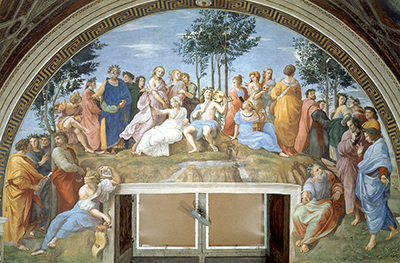The Parnassus painting represents a replica or a sketch that was designed and produced by Raphael who was an Italian artist. The painting is found in the central part of the ceiling in the Villa Albani hall in Rome.
It was the second wall of Stanza della Segnatura, and the painting was commissioned by Pope Julius II between 1509 and 1511. The painting was created in the fresco technique in the year 1961. The other three Raphael's artist's work includes The Cardinal Virtues, The Disputa and The School of Athens which are arguably his most artist works. It is believed that he chose Mount Parnassus as the main setting for his painting because Delphi mainly resided on its slopes.
Delphi was the main location of the sacred shrine of God Apollo who ruled over poetry, music and other fine arts. In the painting, Apollo is the focal point of this art. He is resting under a tree playing the lira da braccio while surrounded by various renowned poets and the nine Muses. Raphael's artist’s work coincided with the use of oil paints in Italy and most of his early paintings seem to use oil. In most of his earliest offerings, he used egg tempera, which was a mixture common with the artists of this generation. By the time he came to settle in Rome, all of his paintings and artworks were executed mainly in oil.
He painted on vellum and paper, and most of Raphael's tapestry cartoons consist of numerous sheets of paper that are glued together. The main medium that was employed in the painting was a specific type of gouache in which the pigments were bound in the animal glue. Based on his paintings, it is believed that he used the oil medium to achieve an excellent depth of the shadow and the richer colours. While he was working on the frescoes in Rome, he employed several assistants, and within some years of settling in the city, he had a large workshop of associates and talented students.
The nature of the contribution is often difficult to discern, and from most of his work, it is unlikely that the division of labour was either systematic or consistent. He seems to have interested himself in both marginal and central parts and intervened in various stages including intermediary, preliminary and final. The entire room shows four areas of human knowledge: poetry, law, philosophy, and religion with the Parnassus art representing poetry. The details in the painting include mythological Mount Parnassus where God Apollo dwells. He is sitting under a tree playing a musical instrument while surrounded by the contemporary poets, nine poets from antiquity and the nine muses.
The painting also includes Apollo together with Calliope who is the muse of the epic poetry and the inspired poets. Raphael, who was the main artist, used the face of the Laocoon from a classical sculpture that was excavated in the year 1506. He also used the Vatican for his Homer displaying blindness rather than pain.




